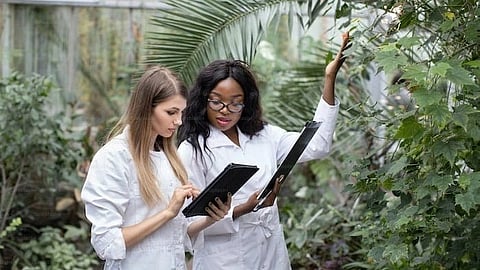

Jack Orebaugh, a forensic anthropology major at the University of Tennessee, Knoxville, has a big heart for families with missing loved ones.
When someone disappears in an area of dense vegetation, search and recovery efforts can be difficult, especially when a missing person’s last location is unknown. Recognizing the agony of not knowing what happened to a family or friend, Orebaugh decided to use his internship at the Department of Energy’s Oak Ridge National Laboratory to find better ways to search for lost and deceased people using cameras and drones.
Orebaugh and ORNL’s Autonomous Systems team mapped UT’s Anthropology Research Facility, a globally recognized body farm for forensic learning and research, to detect nitrogen uptake in plants. Using multispectral cameras on drones, the team took hundreds of photos over the facility. They then used Pix4D software to stitch the photos together into a large map. The software allows Orebaugh to see areas where plants are healthy compared to areas that have less lush or no plants.
“Plants are storytellers about their environment. They are stationary and become sensors of what’s happening around them,” Orebaugh said.
Orebaugh became interested in the system of decomposition during his undergraduate studies. While working at the Anthropology Research Facility over the summer of 2023, he learned about the bigger picture of decomposition. The way a body decomposes is one part of the puzzle, he said. What happens in the environment around the body, to include bugs, soil, plants, air and trees, comprise the rest of the system.
He brought this curiosity to his internship at ORNL and wanted to leverage the strong relationship between the national lab and the Anthropology Research Facility. Through interactions with other students’ research, he devised his own research questions: How do plants respond to decomposition, and can we see it with sensors?
Electronics and Unmanned Systems Staff Member Jairus Hines helped Orebaugh build a research drone with a suitable camera sensor payload for the project.
On a clear, dry day in September, Orebaugh and the team flew the drone over the Body Farm. Orebaugh said flying in autumn gives one snapshot of time in East Tennessee.
“We flew during a time when leaves are dying and falling to the ground,” Orebaugh said. “We don’t know how that impacts the spectral signature of vegetation compared to other seasons.”
Different regions with diverse plants would show different data. Should this research project continue, researchers could amass a large dataset of vegetation indexes in different regions and times of the year. This dataset could then be used to calibrate for different climatic and plant growth factors.
Several other questions remain for Orebaugh’s research. Researchers don’t know how human, animal or plant decomposition impacts the soil and would show up on a multisensory camera. Plants could be healthy for many reasons. Of the data collected this year, Orebaugh said the maps show several areas with bright green vegetation, but why those areas are healthy remains unclear.
Flying drones with different sensors over a variety of terrain could be used in various types of scenarios by government agencies. If a person has been missing for a long time, a rescue responder could use a drone over a large area of land and detect where vegetation is visibly healthy, giving precise coordinates to a ground recovery team to investigate further.
“For the family missing their loved one, this could bring peace to them sooner than we are capable of doing now,” Orebaugh said.
Internationally, this technology could be used to provide data for war crimes.
Of his time at ORNL, Orebaugh spoke highly of his mentors. He took courses at UT Knoxville on remote sensing and drones but was unaware of the function of drones or multispectral imagery. He remarked how his colleagues respected his quest for this research, including appreciating working with the Anthropology Research Facility and for making strides in rescue missions.
“As an intern, I wanted to squeeze everything I could out of this experience,” Orebaugh said. “I wanted to be in a place where ‘yes’ was common.”
After Orebaugh graduates in 2024, he is considering continuing his education in graduate school and expressed a desire to continue answering the questions that pop up as the research progresses.
UT-Battelle manages ORNL for the Department of Energy’s Office of Science, the single largest supporter of basic research in the physical sciences in the United States. The Office of Science is working to address some of the most pressing challenges of our time. For more information, please visit energy.gov/science. (VP/Newswise)
